Relationships are the lifeblood of affiliate marketing—and that’s what makes industry events a goldmine of opportunities. These events allow brands, publishers, creators, and agencies to turn conversations into partnerships, gather industry intelligence, and drive measurable ROI.
But too often, professionals return from these events with little more than business cards, vague promises, and minimal results to show for their investment of time and resources. The difference between merely attending and truly succeeding lies in your approach.
We consulted experts from across affiliate marketing. From brand leaders to publishers, creators, and agency professionals, their diverse perspectives provide a well-rounded framework for success.
This guide explains their proven strategies for transforming industry events into business wins, from thoughtful preparation to intentional networking and actionable follow-ups.
Table of contents:
- Before the event: Laying the foundation for success
- During the event: Making the most of each day
- Virtual and hybrid event considerations
- Post-event: Turning your efforts into results
- Transform your next event into long-term business growth
Before the event: Laying the foundation for success
Preparation is non-negotiable. The time you invest before an event directly impacts the value it delivers.
“I’ve been to hundreds of conferences since entering the industry in 2006, and one of the biggest keys to making the most of affiliate events is planning ahead,” says Paresh Vadavia, Executive Vice President at Gen3 Marketing.
With the right preparation and strategy, you can maximize your impact and make the most of every interaction.
1. Set your event goals to narrow your agenda
Without setting a clear purpose for the event, you risk spreading yourself too thin or missing out on key opportunities.
“Define what you want to achieve, whether it’s networking, learning, or exploring go-to-market strategies. Focus your time based on those goals,” advises Carolina Paradas, Vice President of Growth at Fidel API.
Developing specific goals ensures every interaction and activity has a purpose, giving you measurable results to make the event worthwhile.
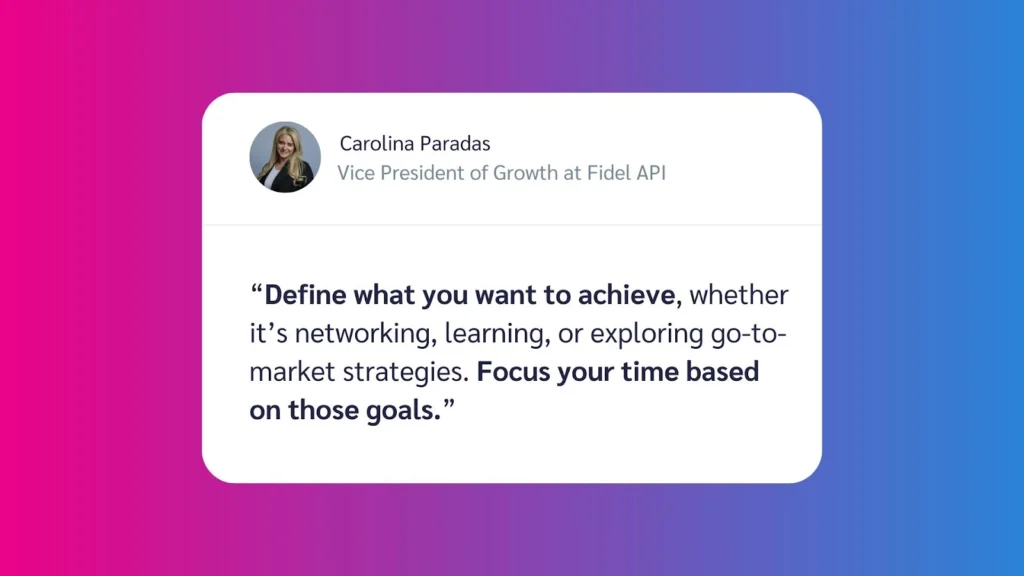
How to do it
Start by understanding your role and objectives. Identify how this ties into the event by considering a few key questions:
- What takeaways do I want to walk away with?
- How does this event align with my job role or immediate tasks?
- Are there knowledge gaps or partnership needs this event can fulfill?
Your company’s larger priorities may also shape your approach. For example, if your company plans to expand into a new market, connect with partners who understand that audience.
Once you’ve determined your priorities, turn your goals into actionable next steps:
- Identify key sessions to attend or influential attendees to connect with
- Use event apps or directories to create a target list of contacts
- Build your schedule around these priorities
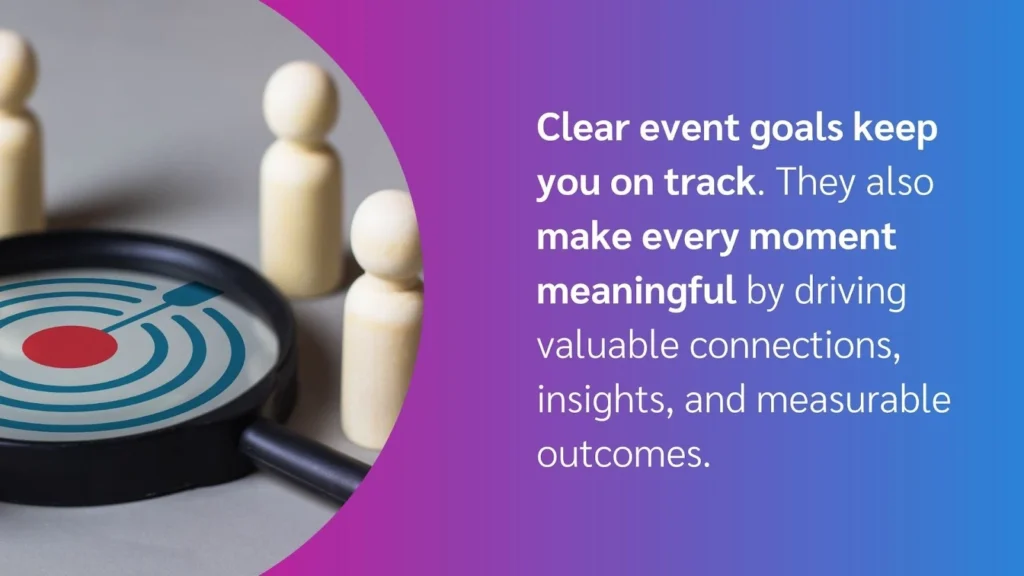
2. Start outreach early through multiple channels
Competition for meetings can be intense, especially among publishers vying for face time with high-profile brands. The earlier you initiate communications, the better.
“Reach out to people before the event, let them know you’ll be attending, and set up meetings in advance,” says Vadavia.
You want to start genuine conversations before the event even begins. By making the first move and using the right channels, you’ll set yourself up for more impactful conversations when its time to attend.
How to do it
Beth Schmitt, Regional Senior Director of Publisher Development at impact.com, recommends starting outreach at least a month before the event to provide ample opportunity to secure responses, schedule appointments, and follow up with non-responders.
“You’ll have potential contacts who won’t respond the first time, so starting early provides room for follow-ups and ensures better scheduling traction,” she advises.
To streamline your outreach process:
- Begin with current partnerships. Use existing contact information to schedule face-to-face check-ins with your established partners.
- Focus on new prospects. Review event apps and attendee lists to identify and prioritize potential connections.
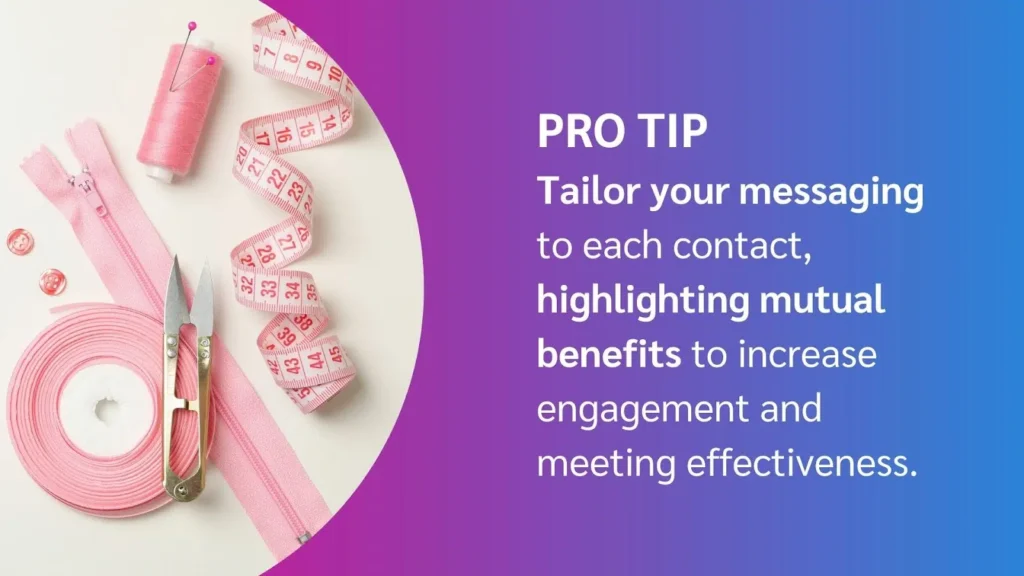
You’ll likely receive plenty of outreach from others, too. Prioritize the most productive requests and make the best use of your time. “Dive into the event app for prospects and do your research to make sure they are good fits,” says Wade Tonkin, Director of Global Affiliate Marketing at Fanatics.
However, don’t exclusively rely on event apps—email and LinkedIn can be great ways to connect with other attendees before the apps are available. “Not every attendee relies on the app alone, so syncing meetings directly to both of your calendars helps avoid last-minute no-shows,” says Jerrid Grimm, Partner Marketing Director at impact.com.
Advanced planning also allows you to personalize your meeting invitations. Include important details to set expectations for the conversation:
- Who you are and your role
- Why the meeting will be valuable to both parties
- A brief agenda or discussion points to guide the meeting
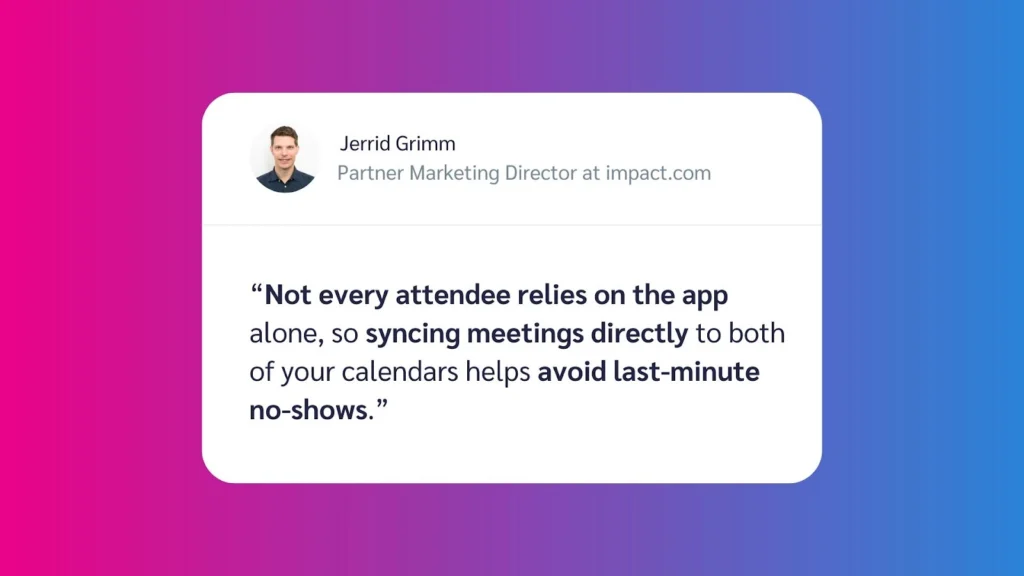
3. Plan your schedule wisely (without overloading it)
Taking the time to strategically organize your time doesn’t mean packing every moment to capacity. “Pre-fill 70 percent of your schedule while leaving room for spontaneous opportunities,” Grimm advises.
The beauty of affiliate industry events lies in the unexpected connections made during breaks, happy hours, or informal lunches. Building flexibility into your schedule allows you to capitalize on these moments without feeling overwhelmed.
How to do it
Balance structured meetings, valuable sessions, and organic networking based on your goals. This approach ensures you maximize your time while staying adaptable.
Here are a few strategies you can try:
- Align meetings with session topics. Grimm suggests inviting prospects to sessions that align with their interests, then using the shared experience as a conversation starter.
- Explore partnership opportunities beyond the obvious. Schmitt highlights that events offer valuable opportunities to uncover direct partnerships, channel partnerships, tech integrations, or thought leadership initiatives that can enhance your program.
- Group your tasks by location. Schedule meetings or activities near each other to minimize travel time within the venue.
- Leave some room for impromptu meetings. “Some of the best connections come from spontaneous conversations,” says Vadavia.
Creating a thoughtful but flexible event plan leads to the most meaningful connections, actionable insights, and measurable results by the time the event concludes.
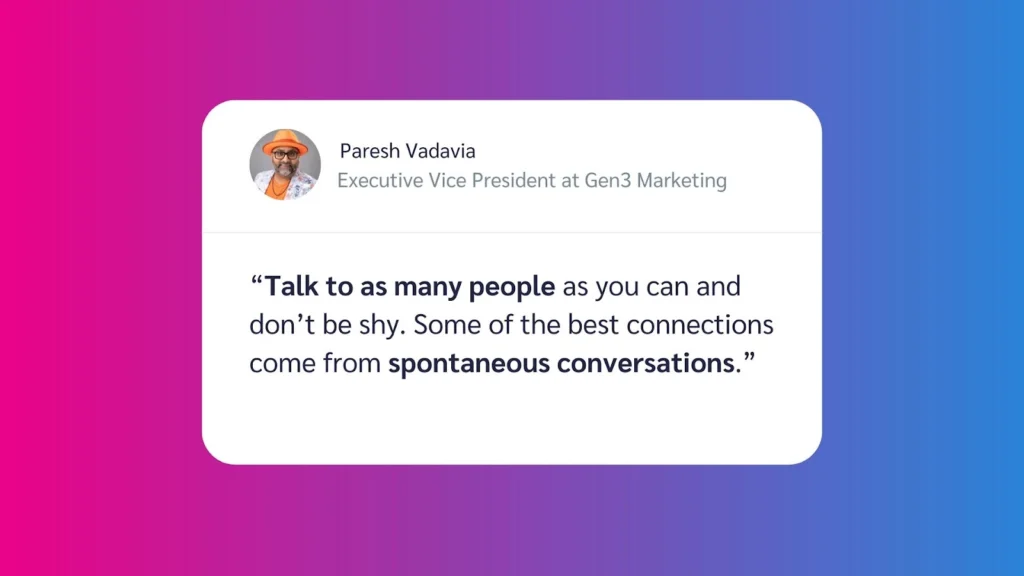
During the event: Making the most of each day
Now that you have a plan in place, it’s time to execute. Events unfold quickly, and your ability to stay present, network intentionally, and manage your energy will define your success.
While a solid plan is important, being too rigid can prevent you from making the unexpected connections and moments that often deliver the biggest impact. Here’s how to execute your plan while staying flexible enough to embrace unexpected opportunities.
1. Use your “unfair advantages” to stand out
In high-stakes events where meeting time is limited, having a clear strategy for standing out is essential.
“These events are filled with some of the most important meetings of the year and give you access to top prospects who might otherwise be hard to reach. You want to take full advantage of these rare, in-person opportunities,” says Grimm. “The unique and proprietary skills and access you have are what startups like to call ‘unfair advantages.’”
Grimm explains that examples of these could be priority access to VIP areas through company sponsorships, tickets to sold-out events, an outgoing personality, sales training to make the most of your conversations, or even a fun sense of style.

How to do it
Securing a sponsorship early is one of the most powerful ways to gain an unfair advantage because it:
- Positions your brand front and center, offering you premium meeting spaces and hosting opportunities to draw in key players.
- Provides access to VIP spaces and quieter areas that are perfect for cutting through busy main event areas and fostering focused discussions.
- Increases your visibility at the event, making you more memorable.
However, sponsorships aren’t the only way to stand out. According to Tonkin, smart personal branding can go a long way. “What is your brand about? What are you passionate about? I’m passionate about cocktails and spirits, and when I get a chance, I leverage this in events to connect with partners,” he says.
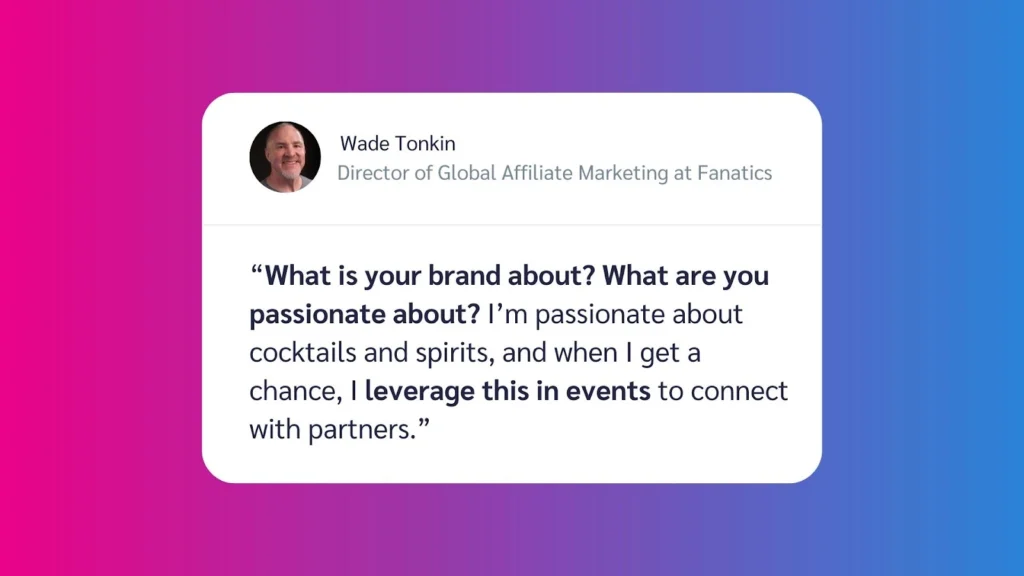
To make yourself visible and approachable:
- Develop a distinct professional style. Dressing in eye-catching yet professional attire can make it easier for others to recognize and engage with you during the event.
- Know the basics about the people you talk to. “Show that you care by doing some basic background research on the people you’re meeting with. I like to check their LinkedIn beforehand so I know the basics about them—like their name, title, previous jobs, and other facts that can serve as conversation starters,” says Grimm.
- Focus on meaningful discussions. “You want to aim for quality conversations. You want to tell a story and invite questions,” says Paradas.
By combining exclusive access with thoughtful visibility and quality interactions, you maximize your advantages while fostering deeper, more impactful relationships.
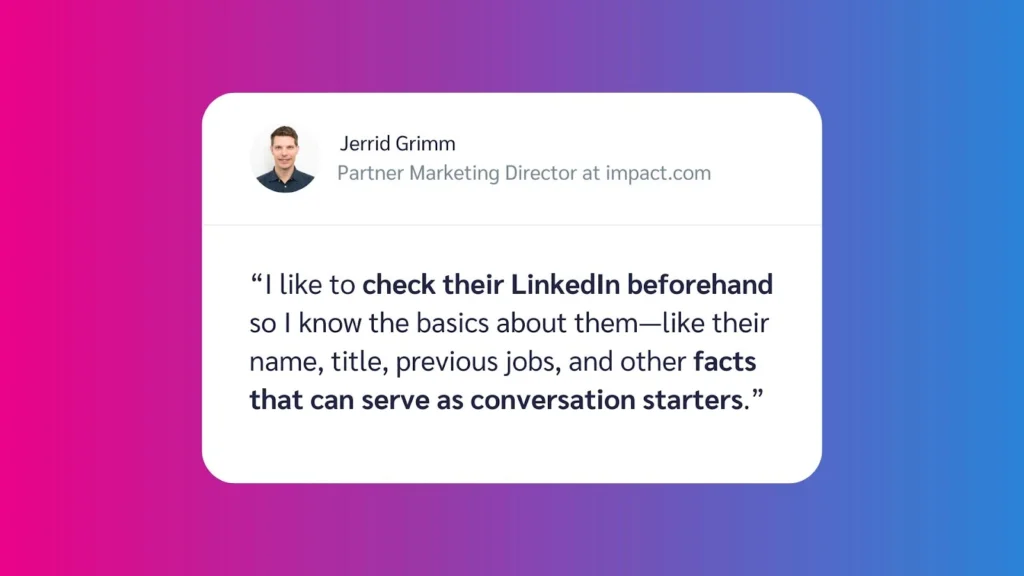
2. Make every interaction count by networking with purpose
Networking at affiliate marketing events isn’t just about collecting business cards—it’s about fostering intentional conversations that lead to meaningful opportunities.
However, establishing purposeful connections in event environments isn’t always easy. Crowds, tight schedules, and the informal nature of certain social settings often make it challenging to seize the right opportunities.
Overcoming these barriers requires a proactive mindset, confidence, and a well-thought-out approach to networking.
How to do it
Preparing clear discussion points and targeted objectives positions you to build partnerships that extend far beyond the event.
“Go into your meetings with a plan, including ideas for promotions or content,” Tonkin suggests. “Those quick wins will get you more attention from the partner moving forward and help justify everyone’s investment.”
To maximize your impact during meetings:
- Arrive with a plan: Outline specific ideas for promotions or collaborative content to discuss with partners.
- Focus on what you can accomplish: Presenting actionable ideas during meetings helps capture attention and demonstrate value to partners.
- Take detailed notes: “You won’t remember what happened in your third meeting once you’re on your 45th,” says Grimm.

Making the most of informal interactions is equally important, especially for those without a booth or dedicated event space.
Lawton Lam, VP of Operations at Yep Ads, emphasizes that intentionality and following up make interactions more meaningful. “No booth? No problem. Our energy, our follow-through, and our focus on real conversations turn every handshake into an opportunity,” he says.
Try these proactive networking strategies:
- Stay at the event venue. “You miss out on a lot of easy networking opportunities socializing around the lobby or the bar if you stay elsewhere,” Tonkin says.
- Introduce yourself to new people. “During happy hours and other laid-back environments, it’s easy to meet one person who can introduce you to a lot of other people and bring you into their network,” explains Schmitt.

3. Keep your energy and motivation strong
To bring your plans to life, you need the energy to keep up. “Be ready for early mornings and late nights,” says Vadavia.
These events are high-intensity environments, full of back-to-back meetings, networking opportunities, and quick decision-making. If your energy dips, it’s easy to miss key moments.
To stay energized and manage event fatigue, preparation is key.
How to do it
Start with the basics:
- Hydrate regularly. Long days and constant conversations can drain you, so keep water on hand to stay sharp and focused.
- Avoid overindulging in alcohol. While evening networking events often include drinks, pacing yourself ensures you can remain productive and engaged the following day.
- Get adequate rest. Prioritize sleep to recover fully from each day and sustain your stamina throughout multi-day events.
Navigating these high-energy environments can feel especially challenging for introverts.
“These events can be overwhelming, so giving yourself some space to rest can help you come back as your best self,” Schmitt says.
Whether that’s stepping outside for a break or carving out a quiet moment to recharge, this thoughtful approach allows you to maintain focus and engage intentionally.
By focusing on health, listening to your limits, and preparing for the event’s pace, you set yourself up to thrive at affiliate marketing events.
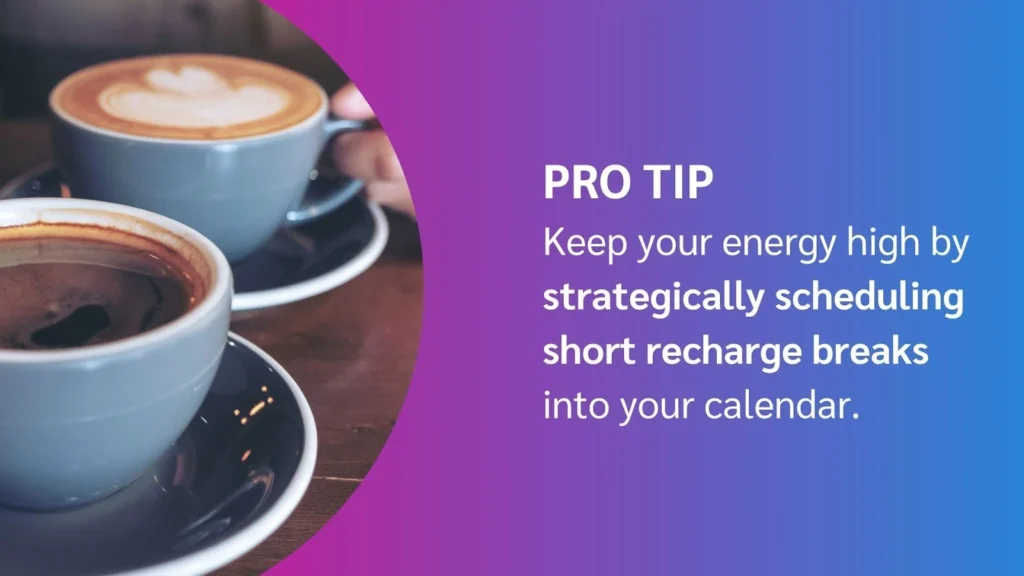
Virtual and hybrid event considerations
While in-person events offer unique relationship-building benefits, virtual and hybrid events have become permanent fixtures in the affiliate marketing industry. These formats require slight adjustments to your approach.
“The principles of preparation, engagement, and follow-up remain the same regardless of format, but virtual environments demand more intentional connection-building,” says Cristy Garcia, Chief Marketing Officer at impact.com.
1. Adapt your strategy for virtual events
Virtual events eliminate travel costs but introduce different challenges: screen fatigue, technological barriers, and fewer spontaneous interactions.
How to do it
To maximize virtual event time:
- Optimize your digital presence. Complete your profile with a professional photo, relevant background, and clear contact information.
- Be more proactive with outreach. “Virtual environments make it easier for people to disappear into the background. Double down on your pre-event outreach and be more assertive about scheduling specific meeting times,” Garcia suggests.
- Master the platform tools. Before the event begins, familiarize yourself with networking features, chat functions, and virtual meeting rooms.
- Create engagement moments. Ask thoughtful questions during sessions, participate actively in chat discussions, and volunteer for interactive opportunities.
- Minimize distractions. Treat virtual events with the same dedication as in-person ones by blocking your calendar, silencing notifications, and creating a professional background.
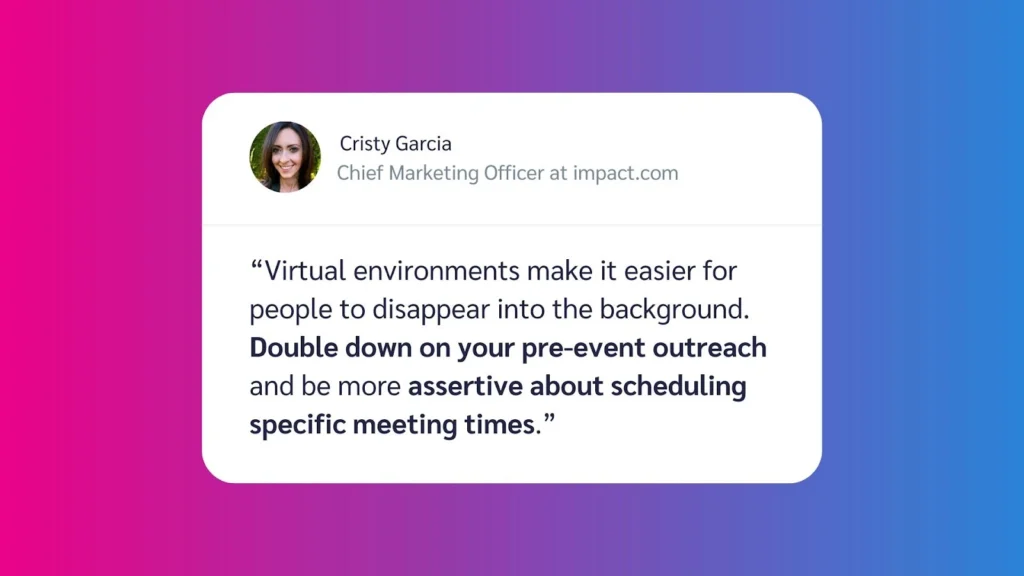
2. Leverage hybrid event opportunities
Hybrid events combine in-person and virtual components, offering unique advantages if you know how to capitalize on them.
How to do it
To maximize your hybrid event experience:
- Strategically choose your format. Determine whether attending in person or virtually better serves your specific goals for each event.
- Connect physical and digital experiences. If attending in person, make time to engage with virtual attendees through the event platform.
- Leverage digital tools for in-person connections. Use the event app to identify and message virtual attendees who might be valuable connections, even if you can’t meet face-to-face.
- Participate in asynchronous opportunities. Many hybrid events offer recorded sessions or extended platform access. Take advantage of these to maximize your investment.
Remember that regardless of format, this guide’s core principles apply—thoughtful preparation, intentional networking, and diligent follow-up remain your keys to success.

Post-event: Turning your efforts into results
What you do after an event is just as crucial as what happens during it. To make the most of your efforts, focus on strategies that solidify relationships, organize insights, and drive long-term value for your business.
1. Follow up quickly to reinforce your connections
Following up after an event is a critical step in turning promising conversations into tangible opportunities. “Relationships are built in the follow-through,” says Vadavia.
Without timely communication, even the most engaging discussions can fade, leaving potential partnerships unrealized. A thoughtful follow-up reassures your contacts that you value their time and are serious about moving forward.
How to do it
Grimm suggests a two-step email system to maximize impact.
Here’s how to approach it:
Step 1: Send a thank-you email within 24 hours
Keep your message short but meaningful. Reference something specific from your conversation to show that you were paying attention.
Step 2: Follow up with actionable next steps a few days later
Reinforce your interest while proposing follow-up actions or providing promised materials.
A generic email risks getting overlooked, but recalling shared goals, common interests, or even a lighthearted moment can make your message shine.
2. Set the groundwork for lasting relationships
Building long-term professional relationships is about transitioning from momentary connections to partnerships that drive ongoing value.
While initial follow-ups are critical to keeping the conversation alive, truly impactful relationships require consistent engagement over time. These long-term partnerships create opportunities for mutual growth, trust, and collaboration that extend well beyond the confines of a single event.
“You want to maintain as many connections at these events as you can, because you’re likely going to see them at the next event—maybe with the same company, maybe a different company,” says Schmitt.
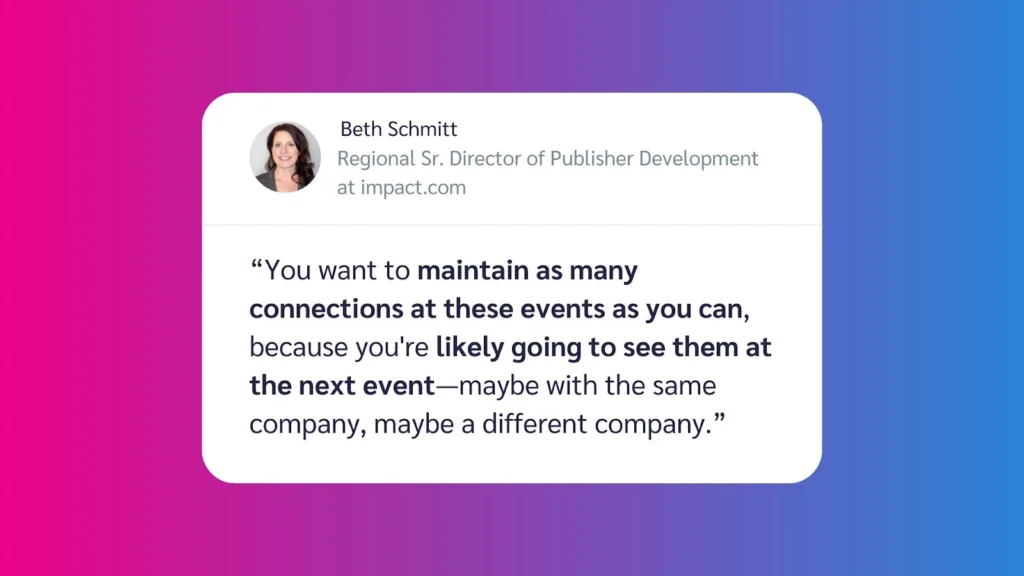
How to do it
Schmitt highlights the value of LinkedIn for extending the value of your event connections.
“When you engage thoughtfully on LinkedIn after meeting someone, you stay on their radar and reinforce the connection every time you interact,” she explains. Small, consistent actions can add up over time.
Building on these digital interactions, deepening relationships through face-to-face meetups can bring even greater value. Consider these steps:
- Plan to meet at upcoming conferences. Schedule coffee chats or suggest attending a session of mutual interest.
- Create opportunities for in-person engagement. Use events as a platform to reconnect in ways that go beyond quick networking.
By blending consistent online touchpoints with intentional in-person interactions, you build a network that drives current results and future opportunities.
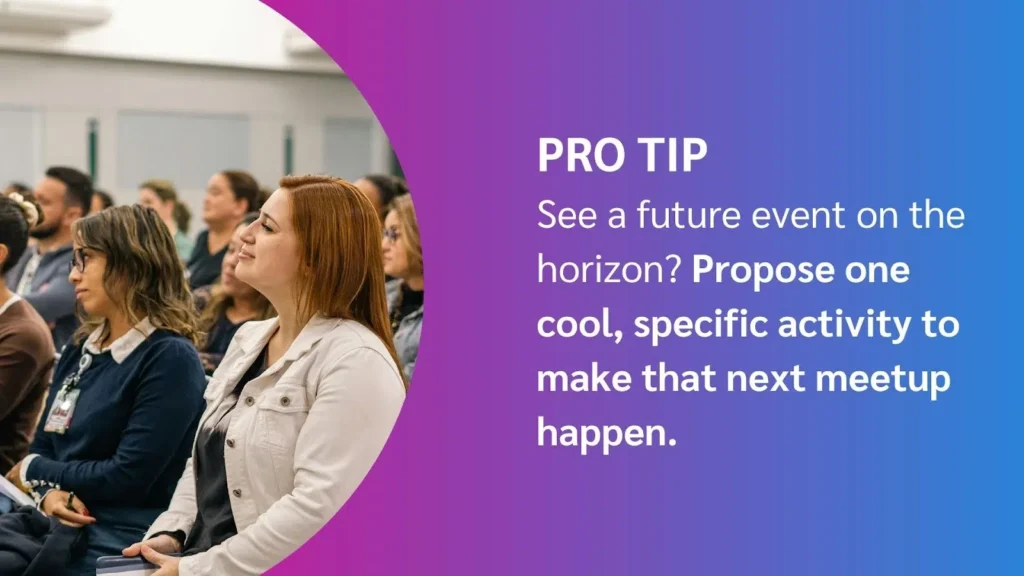
3. Share your event insights to maximize value
Organizing and sharing event insights is essential for driving long-term value and keeping the team aligned.
“Attending these events isn’t just about making money. I want to go back to my company with impactful information. I want to say, ‘This company is experimenting with this, and they told me this is the kind of success they’re seeing. Maybe we should try that or similar,’” says Schmitt.
Properly documenting and distributing these insights ensures that your hard work benefits the whole organization—not just those who attended.
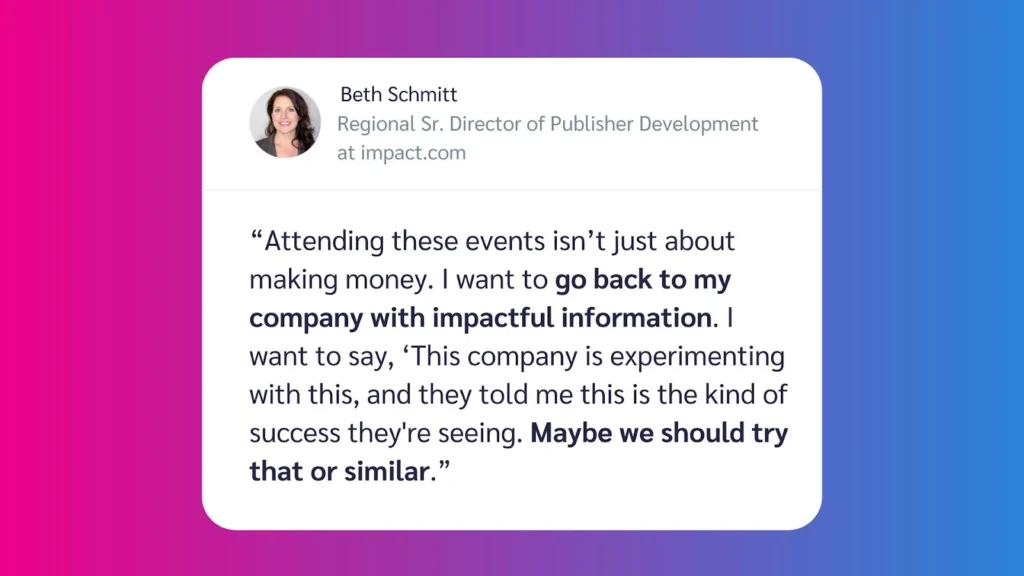
How to do it
Start by creating a comprehensive internal report. This document should cover:
- Key takeaways
- Session highlights
- Major discussions
- Actionable ideas
- Insights related to company objectives
Including details that resonate with your organization ensures the lessons reach the people who can act on them, even if they weren’t there in person.
“When you recap an event, it reminds you of things that you talked about and locks it into your brain. It also extends the value of the event to your team—almost like giving them a little bit of being there,” says Grimm.
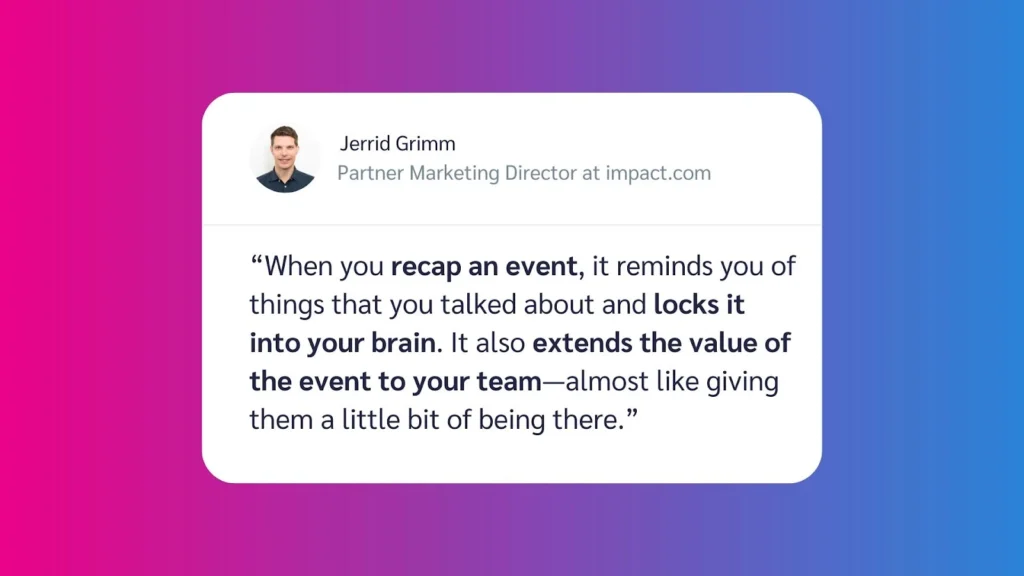
Your reports should deliver actionable insights that align with your company’s goals. Highlight what worked well, challenges you faced, and strategies to improve for next time.
Grimm recommends going a step further by building a library of event reports to capture lessons learned and track progress year over year. This kind of knowledge base becomes a vital resource for future planning.
“You’re going to forget everything by next year. If you have a report, you can remember what worked, what didn’t, and apply those learnings to the next event,” explains Grimm.
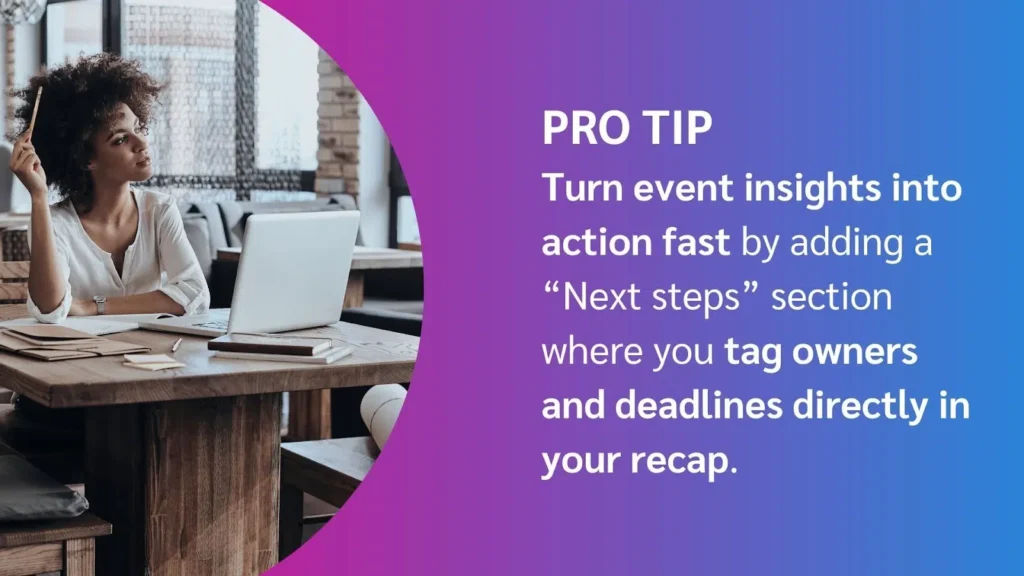
4. Measure your event ROI with meaningful metrics
While the value of relationship-building can be difficult to quantify, tracking specific metrics helps justify your investment and improve your approach for future events.
“Too many companies attend events without a clear way to measure success,” says Garcia. “Setting up measurement frameworks before the event and consistently tracking outcomes afterwards transforms these investments from expenses into strategic assets.”
How to do it
Track both quantitative and qualitative metrics to get a complete picture of your event ROI.
| Short-term metrics (1-30 days post-event) | Medium-term metrics (1-3 months post-event) | Long-term metrics (3+ months post-event) |
| – Number of meetings held vs. planned – New contacts acquired – Follow-up response rate – Content engagement from event-related outreach – Immediate partnership agreements signed | – New partnerships activated – Revenue generated from event-initiated partnerships – Content or promotional campaigns launched – Website traffic from new partner referrals | – Total partnership lifetime value – Relationship retention rate – Program growth attributed to event connections – Year-over-year comparison of results |
“Don’t just track financial metrics,” advises Garcia. “Qualitative insights like team knowledge gained, competitive intelligence, and relationship quality can be just as valuable as direct revenue.”
Create a simple dashboard to visualize these metrics and share them with stakeholders. This approach not only demonstrates the value of event participation but also helps refine your strategy for future events.
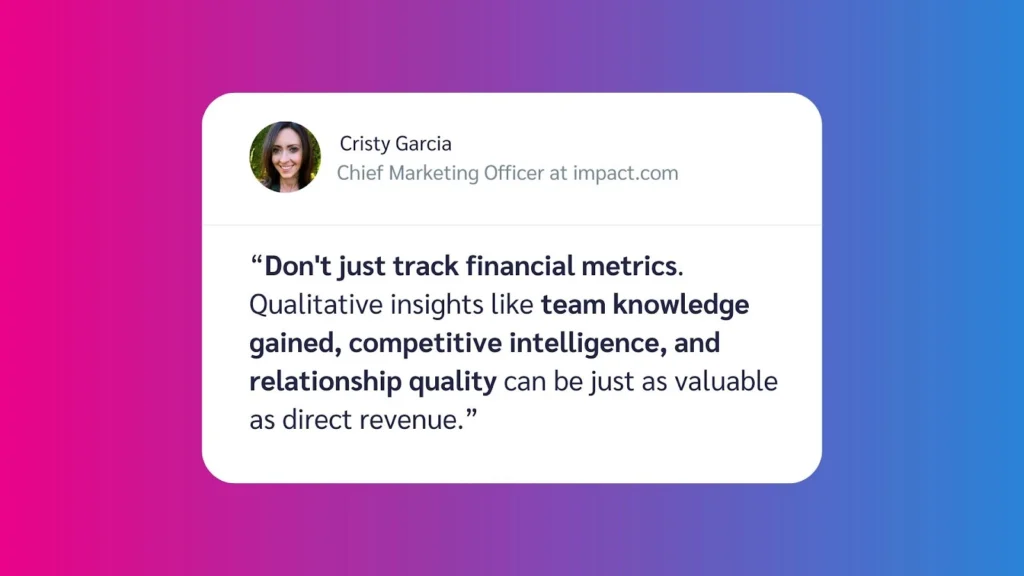
Transform your next event into long-term business growth
Maximizing ROI at affiliate marketing events comes down to strategic preparation, focused networking, and diligent follow-ups.
By setting clear goals, creating meaningful connections, and diligently following up, you can use events as a lucrative way to fuel long-term business growth.
Affiliate marketing events are an investment with the potential for significant returns when approached thoughtfully. Don’t leave that value untapped.
Not in the U.S.? Find another iPX event near you:





